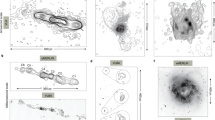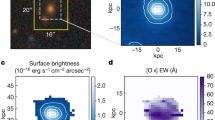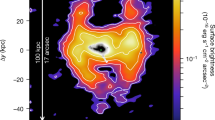Abstract
IN recent attempts1–3 to account for the general radio emission from the Galaxy as the integrated radiation of discrete galactic radio sources, it was found necessary to introduce the effect of ionized interstellar hydrogen, H II regions, to fit the observed radio isophotes at various frequencies. Scheuer and Ryle4 detected, at wave-lengths of 1.4 and 3.7 m., a bright band of emission confined within 2° of the galactic equator superimposed on the general radiation. They identified the bright band with thermal emission from a distribution of H II regions. H II regions are strongly concentrated in the galactic plane. The large source, Cygnus X, has been tentatively described as thermal emission5, perhaps from several bright H II regions surrounding γ Cygni5, or from the integrated radiation of all the H II regions in the spiral arm in the direction of Cygnus8. However, Baldwin6 attempted unsuccessfully to detect, at a wave-length of 1.4 m., a very bright individual H II region, the Orion nebula. Observations of discrete sources have been almost entirely confined to metre wave-lengths, where spectra of more than twenty sources have been obtained7. Piddington and Minnett5,8 observed five discrete sources at a wavelength of 25 cm. and the emission at 25 and 10 cm. from a region near the galactic centre. This was an appreciable extension of the short-wave limit of source spectra.
This is a preview of subscription content, access via your institution
Access options
Subscribe to this journal
Receive 51 print issues and online access
$199.00 per year
only $3.90 per issue
Buy this article
- Purchase on Springer Link
- Instant access to full article PDF
Prices may be subject to local taxes which are calculated during checkout
Similar content being viewed by others
References
Piddington, J. H., Mon. Not. Roy. Astro. Soc., 111, 45 (1951).
Westerhout, G., and Oort, J. H., Bull. Astro. Inst. Netherlands, 11, 323 (1951).
Hanbury Brown, R., and Hazard, C., Phil. Mag., 44, 939 (1953).
Scheuer, P. A. G., and Ryle, M., Mon. Not. Roy. Astro. Soc., 113, 3 (1953).
Piddington, J. H., and Minnett, H. C., Aust. J. Sci. Res., A, 5, 17 (1952).
Baldwin, J. E., Observatory, 73, 155 (1953).
Mills, B. Y., J. Geophys. Res., 59, 149 (1954).
Piddington, J. H., and Minnett, H. C., Aust. J. Sci. Res., A, 4, 459 (1951).
Haddock, F. T., Mayer, C. H., and Sloanaker, R. M., Astrophys. J., 119, 456 (1954); J. Geophys. Res., 59, 155 (1954).
Hagen, J. P., McClain, E. F., and Hepburn, N., Proc. Inst. Rad. Eng. (in the press).
Sharpless, S., Astrophys. J., 118, 362 (1953). Bok, B. J., Bester, M. J., and Wade, C. M. (unpublished). We are indebted to Dr. Bok for directing our attention to these observations.
Hagen, J. P., J. Geophys. Res., 59, 183 (1954).
Baldwin, J. E., and Dewhirst, D. W., Nature, 173, 164 (1954).
Author information
Authors and Affiliations
Rights and permissions
About this article
Cite this article
HADDOCK, F., MAYER, C. & SLOANAKER, R. Radio Observations of Ionized Hydrogen Nebulæ and Other Discrete Sources at a Wave-length of 9.4 cm.. Nature 174, 176–177 (1954). https://doi.org/10.1038/174176a0
Issue Date:
DOI: https://doi.org/10.1038/174176a0
This article is cited by
-
W28-A possible association of supernova remnants and Hii regions
Astrophysics and Space Science (1976)
-
Radio emission of galactic clusters at 1.4 GHz and 2.7 GHz
Astrophysics and Space Science (1971)
-
Millimetre Wave-Length Spectra of the Crab and Orion Nebulae
Nature (1965)
-
Absorption of 3.5-m. Radiation in the Optical Emission Nebula, NGC 6357
Nature (1956)
-
An Alternative Identification of the Radio Source in the Direction of the Galactic Centre
Nature (1955)
Comments
By submitting a comment you agree to abide by our Terms and Community Guidelines. If you find something abusive or that does not comply with our terms or guidelines please flag it as inappropriate.



